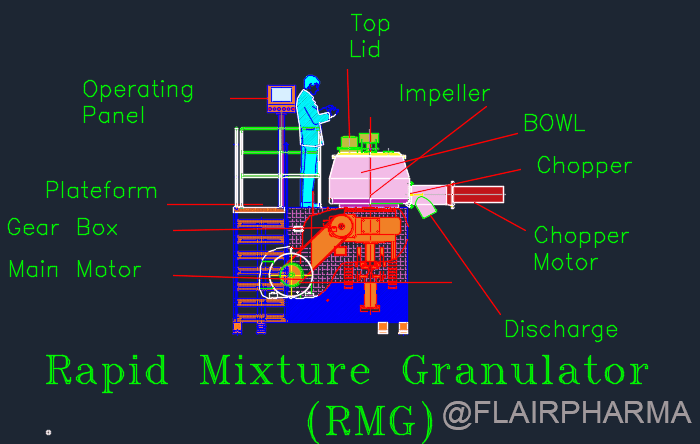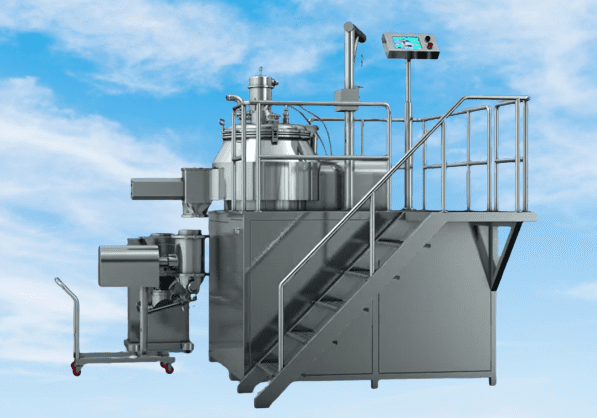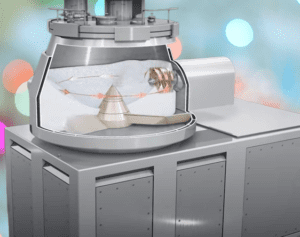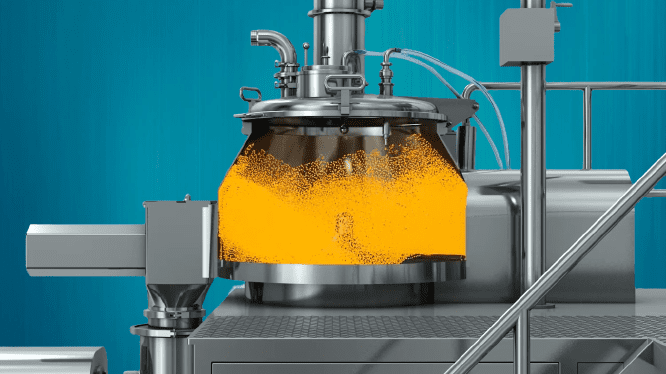Rapid Mixture Granulator (RMG) is equipment that is widely used in pharmaceutical industries for mixing API & excipients. The rapid mixture granulator is a type of process machinery used in the granule-making processes of the chemical and pharmaceutical industries. With RMG, mixing, wetting, and granulation are all done in one step, resulting in quick granule formation and little heat production. This method is frequently used to create granules for tableting or encapsulation that are homogeneous in size and composition. Compared to conventional multi-step granulation procedures, RMG can improve product quality and increase production efficiency.
Process & Utilization:
Rapid Mixer Granulator is used for mixing /blending dry powders, and granules (Active Pharma Ingredients API and Excipients, etc. to achieve a Uniform and homogenous mixture & preparing dough with the addition of binder solution. RMG is the equipment that generates granules from pharmaceutical drug bulk powders. Before mixing all material in RMG the bulk powder is sifted in a Vibratory sifter
Working and Principle of Rapid Mixer Granulator (RMG):
The Rapid Granulator Mixer is designed for mixing active parma ingredients. this will reduce processing time, more homogenous mixing, uniformity of granule size, and, most importantly, uphold better cleanliness. Two key elements that are crucial for the intimate mixing system serve as the foundation for the Rapid Mixer Granulator’s operating principles i.e. spinning near the mixing bowl’s bottom. The impeller creates a swirling, rising, tumbling motion throughout the entire mixture, providing speedy and equitable dispersion of all dry ingredients.
This causes every granule to be evenly wet and distribute all dry components. The purposefully used chopping tool operating at 1440/2880 RPM breaks up the big lumps formed during wet mixing. With the impeller going through the exit on the side of the mixing bowl flush with the bottom, the mixture can be drained. The low profile ensures simple cleaning accessibility. The mixing tool is simply withdrawn from the driving shaft, leaving an open area for mixing that is very simple to clean.

Key Parameters of the Rapid Mixture Granulator (RMG)
The key parameters for a Rapid Mixture Granulator (RMG) in the pharmaceutical industry may vary depending on the specific RMG model, formulation requirements, and operating conditions. However, some common key parameters include:
- Granulation time: The granulation time is the duration for which the RMG operates to achieve the desired granulation endpoint. It is typically determined based on the type and properties of the material being processed, as well as the desired granule size and density.
- Mixing speed: The mixing speed, expressed in revolutions per minute (RPM), is the speed at which the impeller or agitator of the RMG rotates during the mixing and granulation process. It affects the intensity of mixing and can impact the granule size, distribution, and homogeneity. The mixing speed is usually set based on the formulation requirements and material properties.
- Impeller design: The design of the impeller or agitator used in the RMG can affect the granulation process. Different impeller designs, such as paddle, blade, or anchor, can result in different mixing and granulation effects, and the choice of impeller design depends on the specific formulation requirements and desired granulation endpoint.
- Granulation liquid addition rate: The rate at which the granulation liquid is added to the RMG is an important parameter that affects the granulation process. It is usually controlled using a peristaltic pump or a spray system and should be optimized to achieve proper wetting of the material and formation of granules of the desired size and density.
- Inlet air temperature: The temperature of the inlet air used for drying the granules in the RMG can impact the drying rate and the quality of the final granules. It should be controlled and optimized based on the material being processed and the desired moisture content of the granules.
- Screen size: The size of the screen or sieve used in the RMG can affect the granule size distribution. Smaller screen sizes result in smaller granules, while larger screen sizes result in larger granules. The screen size should be chosen based on the desired granule size and distribution as well as the material properties.
- Batch size: The batch size, which is the amount of material processed in a single batch in the RMG, is an important parameter that can impact the granulation process. The batch size should be optimized based on the specific formulation requirements, equipment capacity, and operating conditions to ensure efficient and effective granulation.
It’s important to note that these parameters may need to be adjusted and optimized based on the specific material being processed, formulation requirements, and equipment design to achieve the desired granulation endpoint and product quality. Consulting the RMG manufacturer’s guidelines and conducting trials to determine the optimal parameters for a specific application is recommended.
Configuration of The Rapid Mixture Granulator (RMG):
- Process Bowl Lid.
- Charging Port.
- Product Bowl.

- Side Discharge Port.
- Impeller (Z-Shaped).
- Multi-blade Chopper.
- WIP spray ball.
- WIP nozzle product side discharge.
- VFD for Impeller & Chopper motors.
- Filter cartridge -0.22 micron.
- Calculated torque display.
- Impeller lifting arrangement.
- Lifter For raw material handling.
- Pneumatic impeller lifting device.
- Spraying system (Single drive, single head spray pump) Binder dosing.
- AC Frequency variable drive cone mill to vary the speed.
- AC Frequency variable to vary the speed of bottom beater blades while discharging.
- AC Frequency variable drives to vary the speed of the chopper blade.
- Mechanical seals at the entry point of bottom beater blades and chopper blades pneumatic pressure switch.
- Air Purging interlock with PLC through the airflow sensor.
- Discharge assembly.
- Peristaltic Pump with spray nozzle.
Average Processing Time:
- Dry mixing for around 3 to 5 minutes.
- Wet mixing takes about 5 to 10 minutes.
- Wet Granulation takes about 5 to 10 minutes.
- The discharge will take between 1 and 15 minutes.
Improved Processing using the Rapid Mixture Granulator (RMG) uniform distribution of all constituents in the formulation. a brief period for mixing and granulation. Up to 80% to 40% of the bowl’s volume has usable operating capacity. mild processing produces uniform grains. several uses. Simple upscaling and downscaling between machine sizes No empty spots were left in the design of the bowl.
Capacity Calculation of the Rapid Mixture Granulator (RMG)
The capacity of a Rapid Mixture Granulator (RMG) in the pharmaceutical industry can be calculated using the following steps:
- Determine the volume of the granulation chamber: The granulation chamber of the RMG is the space where the granulation process takes place. It is usually cylindrical in shape and can be calculated using the formula for the volume of a cylinder: V = π * r^2 * h, where “r” is the radius of the chamber and “h” is the height of the chamber.
- Calculate the batch size: The batch size is the amount of material that is processed in a single batch in the RMG. It is usually expressed in kilograms (kg) or liters (L) depending on the type of material being processed. The batch size can be determined based on the desired granulation parameters, such as the target granule size and density, and the formulation requirements.
- Determine the fill volume: The fill volume is the volume of material that can be loaded into the RMG for a single batch. It is usually less than the volume of the granulation chamber to allow for proper mixing and granulation. The fill volume can be calculated by multiplying the volume of the granulation chamber by a fill factor, which is typically around 60-80% depending on the design and operating conditions of the Rapid Mixture.
- Calculate the capacity: The capacity of the Rapid Mixture is the maximum amount of material that can be processed in a given time period, typically expressed in kg/h or L/h. It can be calculated by dividing the fill volume (step 3) by the total time taken for one complete batch cycle, which includes the loading, mixing, granulation, and unloading time. The total time for one batch cycle can be obtained from the Rapid Mixture’s operating manual or by conducting trials to measure the actual time taken for each step.
Here is the formula to calculate the capacity of an RMG:
Capacity = Fill Volume / Total Time for One Batch Cycle
It’s important to note that the capacity of a Rapid Mixture can vary depending on various factors, such as the type and properties of the material being processed, the design and operating conditions of the RMG, and the skill and experience of the operator. Therefore, it’s recommended to consult the Rapid Mixture manufacturer’s guidelines and conduct trials to determine the actual capacity for a specific application.

Formulas and Calculations for Rapid Mixer Granulator (RMG)
-
Batch Size Calculation: Batch Size = Weight per Tablet × Number of Tablets
-
Granulation Time Calculation: Granulation Time = (Weight of Material / Mass Flow Rate) + Mixing Time
-
Impeller Tip Speed Calculation: Impeller Tip Speed = π × Impeller Diameter × Impeller Speed
-
Power Calculation: Power = Torque × Angular Speed
-
Compression Force Calculation: Compression Force = Pressure × Area
-
Granule Density Calculation: Granule Density = Mass of Granules / Volume of Granules
-
Moisture Content Calculation: Moisture Content = (Initial Weight – Dry Weight) / Initial Weight × 100
-
Dissolution Efficiency Calculation: Dissolution Efficiency = (Amount of Drug Released / Initial Drug Content) × 100
-
Particle Size Distribution Calculation: Analyze the particle size using techniques such as laser diffraction or sieve analysis.
-
Blend Uniformity Calculation: Conduct sampling and testing of the blend to determine uniformity based on specified criteria.
-
Yield Calculation: Yield = (Weight of Final Product / Total Weight of Raw Materials) × 100
| Formula/Calculation | Description |
|---|---|
| Batch Size Calculation | Determines the total weight of the batch |
| Granulation Time Calculation | Calculates the required granulation time |
| Mixing Time Calculation | Determines the required mixing time |
| Impeller Tip Speed Calculation | Calculates the speed of the impeller tips |
| Power Calculation | Determines the power requirement of Rapid Mixture |
| Compression Force Calculation | Calculates the compression force during granulation |
| Granule Density Calculation | Determines the density of granules |
| Moisture Content Calculation | Calculates the moisture content in the granules |
| Dissolution Efficiency Calculation | Determines the dissolution efficiency of the granules |
| Particle Size Distribution Calculation | Analyzes the particle size distribution of the granules |
| Blend Uniformity Calculation | Determines the uniformity of the blend |
| Yield Calculation | Calculates the yield of the granulation process |
Control System:
- 21 CFR part 11 compliance SCADA Industrial PC.
- Installation & Commissioning
Documentation:
- Qualification Documentation package (DQ, IQ, P&ID, GA Drawings, Electrical Drawings, etc.)
- Battery limit documents
- All documents are as per URS
You may also read about the:
IMPACT OF RMG SPEED ON WET GRANULATION
FAQ:
What is RMG in granulation?
Answer: The Oral Sodil doses plant has a granulation section. In this granulation section, the major equipment is a high-shear rapid mixture granulator which plays a major role in mixing all pharma ingredients & converts them into fine granules. Pharmaceutical manufacturers use a rapid mixer granulator in granulation for Granule generation and uniform mixing is accomplished by choppers and impellers.
How do you calculate RMG capacity?
How to calculate the working capacity of the rapid mixture granulator?
Answer: To calculate the capacity of the Rapid Mixture, you have to calculate the bulk density which will be processed in the equipment, for example, 600 ltr capacity equipment has working volume capacity i.e. 80% equals to 480 ltr and the drug bulk density is 0.6. Then the capacity calculated = 480 X 0.6 = 288 kg this means that our batch size is 288 kg in 600 ltr model equipment.
What is the working capacity of RMG?
Answer: As briefed in the above answer working capacity is calculated by the drug bulk density. If the density increases then the working capacity increases. if the density of bulk decreases then the working capacity decreases of the equipment.
What is the function of RMG?
Answer: The primary function of the rapid mixture granulator is combining, agitating, and shear mixing, a rapid mixture granulator is employed (to break internal molecular force). Pharmaceuticals employ Rapid Mixture to create granules. The Rapid Mixture’s impeller and chopper play a significant role in the wet granulation process.
What is RMG and FBD?
Answer: Rapid mixture granulator used for the mixing of the different APIs and excipients & convert bulk drugs into fine granules. But FBD is used for drying these bulk with the fluidization process.
What is a Rapid Mixer Granulator (RMG)?
Answer: A Rapid Mixer Granulator (RMG) is a high-speed equipment used in the pharmaceutical industry for the granulation process. It combines powders, binds them together, and forms granules suitable for tablet manufacturing.
What are the main components of an RMG?
Answer: The main components of a Rapid Mixture include a mixing bowl, impeller, chopper assembly, discharge port, control panel, and drive mechanism. The mixing bowl holds the materials, the impeller provides mixing action, the chopper assembly helps in granule size reduction, and the discharge port facilitates the removal of granules.
How does an RMG achieve granulation?
Answer: The Rapid Mixture achieves granulation by employing a combination of mechanical forces. The impeller and chopper assembly create intense mixing and granulation action, leading to the formation of granules. The impeller promotes blending and uniform distribution of powders, while the chopper assembly breaks down larger particles to achieve the desired granule size.
What are the advantages of using an RMG?
Answer: Some advantages of using a Rapid Mixture include improved granule homogeneity, enhanced flow properties, increased compressibility of granules, reduced processing time, efficient wet massing, and precise control over granule size distribution. Additionally, the Rapid Mixture offers automation features and facilitates easy scale-up for commercial production.
How does an RMG handle wet granulation?
Answer: In wet granulation, the Rapid Mixture combines powders with a liquid binder. The impeller facilitates uniform wetting of the powders, and the chopper assembly assists in breaking down agglomerates and achieving the desired granule size. The Rapid Mixture also provides controlled drying to remove moisture from the granules.
What safety features should be considered when using an RMG?
Answer: Safety features of a Rapid Mixture may include interlocks to prevent operation when the equipment is not properly assembled, emergency stop buttons, overload protection, safety sensors, and appropriate guarding to prevent operator injury. It is important to follow safety guidelines and conduct regular maintenance to ensure safe operation.
How can the RMG be optimized for specific formulations?
Answer: Optimization of the Rapid Mixture for specific formulations involves adjusting various parameters such as impeller speed, chopper speed, mixing time, binder addition rate, and drying conditions. Process validation and experimentation are conducted to determine the optimal settings that yield desired granule characteristics.
What challenges can arise during RMG operation?
Answer: Challenges that can arise during Rapid Mixture operation include powder sticking to the bowl walls, insufficient granule formation, inconsistent granule size, excessive heat generation, and over-mixing leading to undesirable effects on the final product. Addressing these challenges requires careful monitoring, adjustment of process parameters, and troubleshooting.
How is cleaning and maintenance of an RMG performed?
Answer: Cleaning a Rapid Mixture involves disassembling the equipment, removing residual material, and cleaning the parts thoroughly using appropriate cleaning agents. Maintenance activities include lubrication of moving parts, inspection of seals and gaskets, calibration of sensors, and routine checks to ensure proper functioning and prevent equipment downtime.
What regulatory considerations are associated with using an RMG in pharmaceutical manufacturing?
Answer: When using a Rapid Mixture in pharmaceutical manufacturing, adherence to regulatory standards such as Good Manufacturing Practices (GMP) is crucial. Compliance with documentation, validation requirements, equipment qualification, cleaning validation, and record-keeping is necessary to ensure product quality, safety, and regulatory compliance.
For more technical details, best equipment vendor comparison, or any type of documentation. (SOP,DQ,IQ,OQ,PQ etc.) Please contact:admin@flairpharma.com
You may also click for guidelines here.

2 thoughts on “Rapid Mixture Granulator (RMG) Technology & its Values 23”